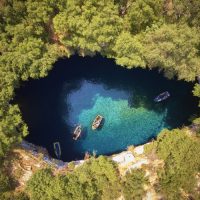If you are planning your dream European vacation, or even considering moving to Europe, you may wonder if there are snakes on the continent.
The short answer is yes, although there are a few countries in Europe with no snake populations.

Contents
So… Are There Snakes in Europe?
Yes, there are plenty of snakes in Europe.
However, most countries have only a few venomous species.
Snakes are found in every country in Europe except for Iceland, Greenland, and Ireland.
These countries have a few things in common.
They are surrounded by water, and they have colder climates.
These two factors make it hard for snakes to get to, and it is inhospitable.
Snake Species in Europe
Europe has many species of snakes.
However, some are closely related, so we’ll take a look at families and subfamilies to get a broader view of Europe’s serpent species.
Viperidae (Viper)
We’ll start with the snakes that pose a danger to humans.
Snakes in the Viperidae, or viper, family are venomous.
These snakes can cause injury and even death in rare cases.
The European Viper, also known as the European Adder, is the most common venomous snake in Europe.
It’s highly adaptable and can be found in woodlands and city streets.
Their range is impressive, extending from Great Britain to Greece, Scandinavia, and China.
The good news is that bites from this snake are frequent because it’s so common, but hospitalizations are very rare.
Most people have a mild reaction to the venom.
The Nose-Horned Viper, also known as the European Viper, is the most venomous snake found in Europe.
Bites from this snake require medical treatment, and usually hospitalization.
Deaths have occurred from nose-horned viper bites.
Other members of the European viper family include asp viper, meadow viper, Haley’s pit viper, and the Ottoman Viper.
Colubridae
Colubridae is the other large snake family in Europe.
Racer snakes and whip snakes are subfamilies of Colubridae.
Racers get their name for their ability to move quickly, particularly when they feel threatened.
Some can travel up to 3.5 miles an hour.
Common racers include the dwarf racer, slender, racer, and red-bellied racer.
Whipsnakes have a pattern on their body that looks like a braided whip.
Common European whipsnake species include the Caspian whip snake and the Balkan whip snake.
Is it Safe to Go on a Trek in Europe?
Europe has incredible wilderness to enjoy, but is it safe?
Yes, you can safely explore Europe.
However, there are some dangers you should be aware of when planning your trip.
Snakes
There are about 8,000 venomous snake bites each year in Europe.
15% of these bites are severe or life-threatening.
There’s an average of 4 deaths each year due to snake bites on the continent.
Given the large population of Europe, this is a very low number.
America has more snake bite deaths each year than the entire European continent.
Eurasian Black Bear
The Eurasian black bear is found throughout much of Europe and Asia.
They aren’t typically aggressive, but human attacks have occurred.
Bears are large mammals with razor-sharp claws and powerful muscles, so attacks often result in serious injuries and death is possible.
Natural Disasters
Europe has natural disasters, including earthquakes, landslides, flooding, and wildfires.
50 million people have been affected by natural disasters in Europe in the last 40 years.
Severe Weather
You should also be on the lookout for severe weather when you are in Europe.
These dangers include droughts, forest fires, heatwaves, thunderstorms, and tornadoes.
One of the biggest weather-related risks in Europe is hypothermia.
25,000 people die of hypothermia in England alone each year, and the death rate increases across Europe as the temperature drops.
Snowstorms and blizzards are particularly dangerous when you are in the wild because it’s very difficult to see or travel.
If you are exposed to the temperatures for too long, it is fatal.
Heatwaves can also be deadly, but they are much less dangerous than frigid temperatures.

Interesting Snake Facts in Europe
Most snakes stay on the ground, but several European snakes are excellent climbers.
These include the ladder snake, cat snake, aesculapian snake, and the European rat snake.
Some European snakes hibernate during the winter months.
They make their home in burrows, tree stumps, and rock crevices.
Their metabolism slows down, allowing them to survive the cold months without feeding.
European adders are the only snakes that can live above the Arctic Circle.
They have special adaptations, including the ability to flatten their body to increase their surface area to soak up the sun’s rays.
These snakes also live at the highest elevations, up to 2,500 meters, or 8,000 feet.
It’s theorized that the asp viper is the species that bit and killed Cleopatra.
This viper has anticoagulant effects, which cause bleeding from the eyes and other areas.
While some species of snake, including the European viper, are common across Europe, some species are threatened or endangered.
These snakes are protected by law due to their low populations.
Even though some snakes are dangerous, they are a critical part of the ecosystem.
3 Safety Tips for Exploring Nature in Europe
1. Learn to Read Signs
When you hike in Europe, you’ll likely encounter signs in a language other than English.
These signs can give you valuable information about your direction and potential dangers, so it’s a good idea to learn keywords you may see on your trek.
2. Let Someone Know Where You Are Going
This is essential if you are hiking alone.
Tell someone where you are going, and when you plan to be back.
If you aren’t back at the appointed time, the other person should contact the authorities.
3. Prepare for the Weather
Weather in Europe can be unpredictable and extreme.
Before you go out, check the forecast.
If conditions are going to turn dangerous, wait.
Be sure to have appropriate clothing, including extra clothing in the winter.
Summary
Europe has many snakes, but most aren’t dangerous to humans.
There are only a few deaths on the continent due to snake bites each year.
However, bites do occur.
Given Europe’s breathtaking wilderness, it’s a great place to visit.
Frequently Asked Questions
What is the largest snake in Europe?
The largest Caspian whipsnake is believed to be the largest snake in Europe.
They typically grow to 140-160 cm, or 4 1/2 to 5 feet long.
Some have been found to reach 6 1/2 feet long or bigger.
These impressive snakes are typically active during the day and aren’t a threat to people.
How many snakes are in Europe?
There are 50 species of snake in Europe.
These snakes are the members of 5 families.
The largest families are Colubridae and Viperidae.
What should I do if I encounter a snake?
If you see a snake, just move away from it slowly.
Never attempt to handle a snake, even if it’s not venomous.
If it’s in an inhabited area, contact the local wildlife authorities so they can remove it safely.
What is the smallest snake in Europe?
The smallest snake in Europe is the European worm snake.
It looks more like a worm than a snake and reaches 20 cm or less than 1 1/1 feet in length.











